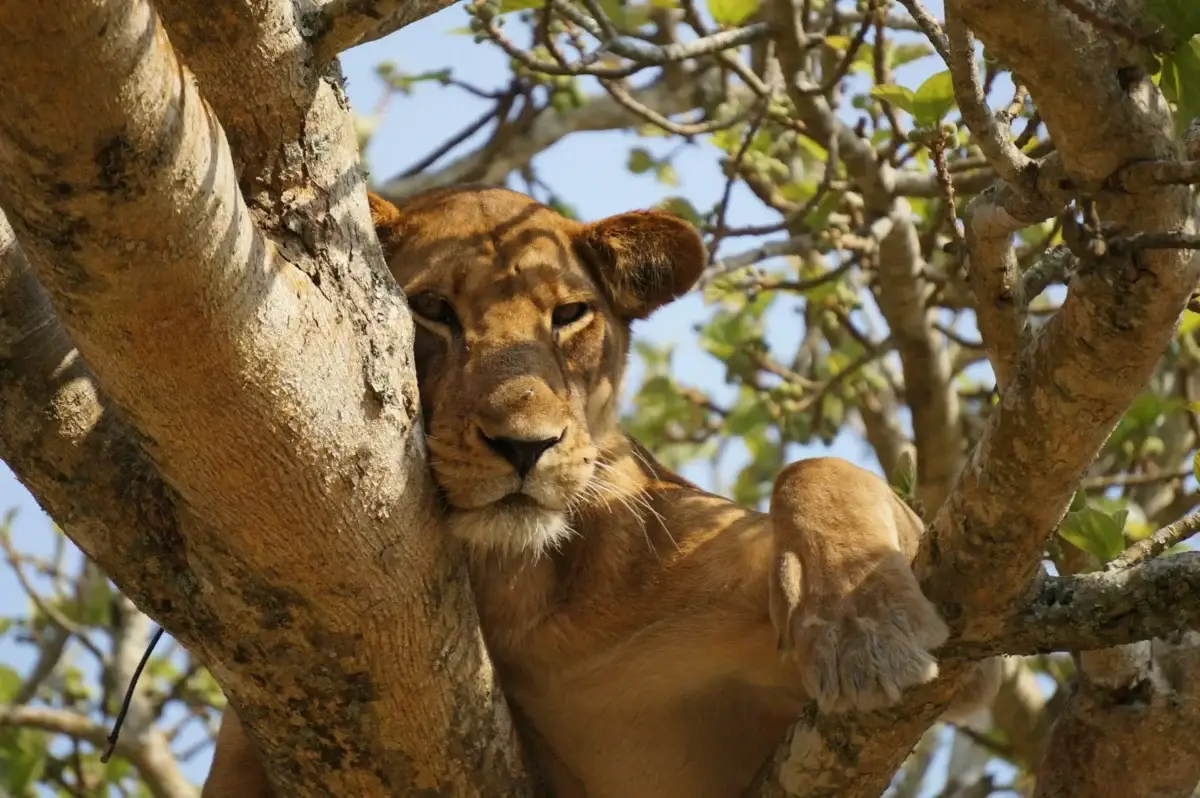Explore Queen Elizabeth National Park, Uganda’s most stunning wildlife haven. Discover its unique tree-climbing lions, rich biodiversity, thrilling safaris, and how to get there.
Queen Elizabeth National Park (QENP) is Uganda’s most visited and biodiverse wildlife reserve. Spanning 1,978 square kilometers, this stunning park is located in western Uganda, stretching across the districts of Kasese, Kamwenge, Rubirizi, and Rukungiri. It was established in 1952 and later named after Queen Elizabeth II to commemorate her visit in 1954.
Nestled within the Albertine Rift Valley, QENP offers a breathtaking landscape of savannah plains, lush forests, volcanic craters, wetlands, and lakes. It boasts over 95 mammal species and more than 600 bird species, making it a true haven for nature lovers.
The Unique Wildlife of Queen Elizabeth National Park

Queen Elizabeth National Park is a wildlife enthusiast’s dream, home to the famous Big Five (lions, leopards, elephants, buffaloes, and rhinos), although rhinos are found at the nearby Ziwa Rhino Sanctuary. Other incredible animals include:
- Tree-climbing lions in the Ishasha sector
- African elephants roaming the savannah
- Hippos and crocodiles in the Kazinga Channel
- Uganda Kobs, waterbucks, and bushbucks
- Chimpanzees in Kyambura Gorge
- Giant forest hogs and spotted hyenas
The Tree-Climbing Lions of Ishasha – A Rare Phenomenon
One of the most unique attractions of Queen Elizabeth National Park is its tree-climbing lions, which are rarely found elsewhere except in Tanzania’s Lake Manyara National Park. These majestic lions can be spotted lounging on fig and acacia trees, usually escaping the midday heat or surveying the area for prey.
Why do they climb trees?
- To avoid insects and parasites on the ground.
- To get a better view of potential prey.
- To stay cool in the hot savannah.
Activities in Queen Elizabeth National Park
There are different must-do activities that you don’t want to miss out on when you get to Queen Elizabeth National Park. Below are the activities for you choose the ones that you are most interested in.
Game Drives
Game drives in QENP offer an opportunity to see wildlife up close, especially early in the morning or late in the evening. The Kasenyi Plains and Ishasha sector are the best spots to see lions, elephants, and antelopes.
Boat Safaris on the Kazinga Channel
A boat safari along the Kazinga Channel provides a close-up view of hippos, crocodiles, and birds. The 32-kilometer-long channel links Lake George and Lake Edward, offering a relaxing but wildlife-packed experience.
Bird Watching
Queen Elizabeth National Park is a birding paradise, boasting over 600 bird species. Some rare sightings include:
- Shoebill stork
- African fish eagle
- Pink-backed pelicans
Chimpanzee Tracking in Kyambura Gorge
Known as the “Valley of Apes,” Kyambura Gorge is home to chimpanzees. Trekking through its lush rainforest offers an unforgettable experience.
Nature Walks and Hiking
Enjoy walking safaris through the Maramagambo Forest or the Crater Lakes region, where you’ll see unique landscapes, caves, and salt mines.
Cultural Encounters
Interact with local Banyaruguru and Bakonzo communities, experience their music, dance, and storytelling, and learn about traditional salt mining.
Hot Air Balloon Safari
For a bird’s-eye view of the park, take a hot air balloon safari, offering unparalleled sunrise views over the savannah.
Sport Fishing
Try catching Nile perch and tilapia in Lake Edward under a guided fishing tour.
How to Get to Queen Elizabeth National Park
By Road
From Kampala, the park is about 400 km away. Travel options include:
- Via Mbarara (6–7 hours) – The most common route via Masaka and Bushenyi.
- Via Fort Portal (7–8 hours) – A scenic route passing through Kibale National Park.
By Air
Chartered flights from Entebbe Airport land at Mweya or Kasese airstrips, reducing travel time to about 1 hour.
Best Time to Visit Queen Elizabeth National Park
- Dry Seasons (June–September & December–February) – Best for game viewing as animals gather near water sources.
- Wet Seasons (March–May & October–November) – Ideal for bird watching but roads can be muddy.
Why Tourists Thirst to Visit Queen Elizabeth National Park
- Unique tree-climbing lions
- Diverse landscapes and rich biodiversity
- Boat safaris unlike anywhere else
- Rare bird species
- Authentic cultural experiences
(Insert an image here: Tourists on a game drive, capturing photos of elephants.)
8. Unique and Fascinating Facts About Queen Elizabeth National Park
- One of Africa’s most biodiverse parks
- Named after Queen Elizabeth II
- Home to over 600 bird species – more than Europe combined
- A designated UNESCO Biosphere Reserve
Conservation Efforts and Sustainability
The park is managed by the Uganda Wildlife Authority (UWA), with projects focusing on:
- Anti-poaching patrols
- Community tourism initiatives
- Habitat restoration
Travel Tips for Visiting Queen Elizabeth National Park
- Carry binoculars and a camera.
- Wear neutral-colored clothing.
- Use insect repellent for mosquitoes.
Frequently Asked Questions
Q: Are the tree-climbing lions easy to spot?
A: Yes, in the Ishasha sector, but it depends on the time of day.
Q: What is the entrance fee?
A: The fee varies but is around $40 per person for foreign tourists.
Conclusion
Queen Elizabeth National Park is a must-visit destination in Uganda, offering unparalleled wildlife experiences, breathtaking scenery, and unique adventures. Whether you’re looking for a thrilling game drive, a relaxing boat safari, or an immersive cultural experience, this park has it all

